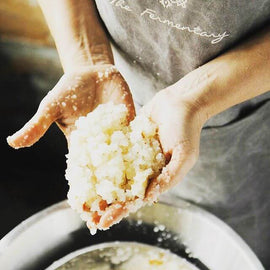There is a word in Korean 'Kimjang' that we hold as an ideal at The Fermentary with our workshops, events and get-togethers. Kimjang describes communities coming together to make and share large amounts of kimchi, getting together not just so each family can take away enough to sustain them through the winter ahead, but also to share ideas, stories and the passing on of heritage, recipes and tradition - each of those as important as the kimchi. The kimchi as the conduit for all of that. Somehow - passing on ferments always feels like that to us.
Traditionally, Kimjang preparations follow the seasons; spring is for fermenting fish, summer is for drying salt, late summer is when the Gochugaru chilli is dried and ground into powder, all in readiness for wombok harvest and Kimjang in late autumn. Kimjang holds the ideal of community - friends and families gathering in the spirit of doing together, sharing in food and tradition, living in harmony with each other, the season, and nature.
Our main driver at The Fermentary is to share knowledge with our larger community, making sure these food traditions are celebrated and remembered - I can't count how many times we've brought together a group to make kimchi and Tei from Dimibang working with the Korean consulate saw this in The Fermentary and asked me to speak and demonstrate this at Korea Week last November. At Fed Square and on the big screen.
Actually - this beautiful kimchi recipe came from a collaboration with Tei. Annoyingly, Melbourne put on it's best dress, (pouring rain and driving winds)... but I was honoured to be there for the festival-goers who braved the storm, standing umbrella in hand to watch and learn.
As you may know, there are as many kimchi recipes as there are kimchi makers, the flavour of 'the hand' playing a huge part in the flavour. This one is quite different to The Fermentary's usual recipe, it requires an element of cooking as well. Some of these ingredients can be tricky to find in Australia, so a quick trip to an Asian supermarket might need to be on the cards.
You might notice that this recipe makes quite a lot of kimchi, in fact, it will easily fill 6 of our fermenting jars or one of our beautiful hand-made kimchi crocks. We've kept the recipe this size because making kimchi is best done with friends. In Korea it has long been a treasured collective community practice, called Kimjang.
Makes about 6 litres
Ingredients
- 3 Wombok cabbages
- 15% brine (2L water and 300g salt)
Kimchi Marinade
- 2 daikon
- 1 bunch of garlic chives
- 4 carrots
- 1 bunch of spring onions
Kimchi paste
- 30g ginger
- 150g garlic
- 200ml Korean fish sauce (omit if you prefer)
- 70ml Korean shrimp sauce (omit if you prefer)
- 220g Gochugaru
- 100ml plum extract (omit or use a sour fruit of choice)
- 100g white sugar ( this can be substituted with fruit)
Porridge
- 50g Glutinous rice flour
- 30g Sweet potato flour (or just rice flour if you can't find)
Method
Brining the wombok cabbage
- In a large container, combine 2L of cold water and 300g of sea salt to make a 15% brine. (Make sure the salt has fully dissolved). Note: Brining is a stage that you can add a few things like kelp, chili, and other ingredients that might make a subtle flavour difference later on. I usually add a piece of kelp.
- Trim off the tough and dirty outside cabbage leaves halve. Place the pieces into the cold brine for 5 hours or overnight, agitating once or twice if you can. I often do this part in a very clean sink before going to bed.
- (Wake up) Remove the cabbages from the brine, they should feel soft and be flexible enough to bend without breaking. Pull from the brine and rinse, then place them in a colander to drain.
Making the rice porridge
- Put a small pot over a medium heat, continually whisk the glutinous rice flour and sweet potato starch with 1 cup of water until it reaches a boil.
- Keep whisking for 2 minutes until the paste looks like porridge. Remove from heat, transfer to a container and refrigerate or let sit until it cools.
Making the kimchi paste
- Julienne the white radish and carrot and then slice the spring onion, garlic chives into lengths, I prefer about 5cm.
- Blend all the Kimchi paste ingredients in the food processor until you get a smooth paste.
- Combine both the paste and the cooled rice porridge, mix with the julienned vegetables.
Place the brined cabbage into a big bowl. If you've chopped the wombok, the just mix the paste thoroughly. If you've left it in halves, gently pull each layer, and smear or wipe the paste mix liberally, coating each layer until the whole piece is covered.
Press the vegetables down quite firmly into your chosen vessel. This could simply be good quality plastic container with a lid. You should easily have enough juice to cover all of the vegetables, so you don't need to weigh the kimchi down. Seal with your chosen lid and wither leave it on your bench for a few days or pop straight into the fridge. The flavour will change and sour, become lively over time but is ready to eat after a couple of days. I like minimum 7 days. It's good to stay in the fridge for months. The older it gets the more likely it is you'll use it to cooke with in soups and things like that.


